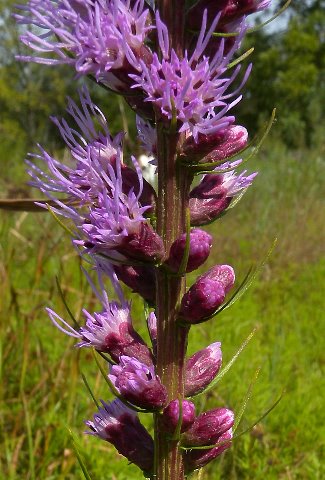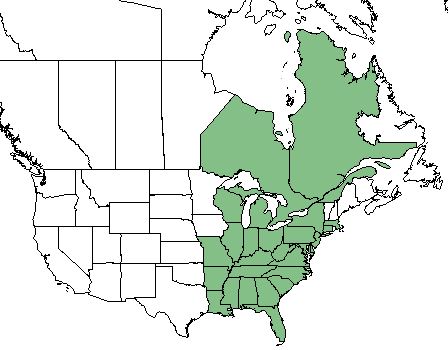Difference between revisions of "Liatris spicata"
Juliec4335 (talk | contribs) |
|||
| Line 33: | Line 33: | ||
===Habitat=== <!--Natural communities, human disturbed habitats, topography, hydrology, soils, light, fire regime requirements for removal of competition, etc.--> | ===Habitat=== <!--Natural communities, human disturbed habitats, topography, hydrology, soils, light, fire regime requirements for removal of competition, etc.--> | ||
''L. spicata'' is found in bogs, wet longleaf pine savannas, seepages, prairies, roadsides, and grassy balds. <ref name= "Weakley 2015"> Weakley, A. S. (2015). Flora of the Southern and Mid-Atlantic States. Chapel Hill, NC, University of North Carolina Herbarium. </ref> Specimens have been collected from moist loamy soils, sandy ridge, edge of cypress pond, pine flatwoods, savanna, disturbed areas such as roadside and ditches, grass-sedge bog, and hardwood hammock.<ref name = "FSU herbarium"> URL: http://herbarium.bio.fsu.edu. Last accessed: June 2018. Collectors: Loran C. Anderson, A.P. Anderson, R.K. Godfrey, R.L. Lazor, Ginny Vail, John Nelson, John Morrill, R. Kral, Lovett Williams, P.L. Redfearn, C. Jackson, Sidney McDaniel, Robert Doren, H.A. Davis, Steve Orzell, Edwin Bridges, Cecil Slaughter, R.F. Thorne, R.A. Davidson, Wm. G. Atwater, R. Komarek, Lisa Keppner, Katelin Pearson, Donald. Davidson. States and counties: Florida (Franklin, Levy, Washington, Wakulla, Okaloosa, Santa Rosa, Gulf, Escambia, Walton, Calhoun, Bay, Taylor, Bradford, Duval, Palm Beach, Indian River, Baker, Taylor, Liberty, Flagler, Pinellas, Dade, Collier, Volusia) Georgia (Thomas) South Carolina (Georgetown)</ref> | ''L. spicata'' is found in bogs, wet longleaf pine savannas, seepages, prairies, roadsides, and grassy balds. <ref name= "Weakley 2015"> Weakley, A. S. (2015). Flora of the Southern and Mid-Atlantic States. Chapel Hill, NC, University of North Carolina Herbarium. </ref> Specimens have been collected from moist loamy soils, sandy ridge, edge of cypress pond, pine flatwoods, savanna, disturbed areas such as roadside and ditches, grass-sedge bog, and hardwood hammock.<ref name = "FSU herbarium"> URL: http://herbarium.bio.fsu.edu. Last accessed: June 2018. Collectors: Loran C. Anderson, A.P. Anderson, R.K. Godfrey, R.L. Lazor, Ginny Vail, John Nelson, John Morrill, R. Kral, Lovett Williams, P.L. Redfearn, C. Jackson, Sidney McDaniel, Robert Doren, H.A. Davis, Steve Orzell, Edwin Bridges, Cecil Slaughter, R.F. Thorne, R.A. Davidson, Wm. G. Atwater, R. Komarek, Lisa Keppner, Katelin Pearson, Donald. Davidson. States and counties: Florida (Franklin, Levy, Washington, Wakulla, Okaloosa, Santa Rosa, Gulf, Escambia, Walton, Calhoun, Bay, Taylor, Bradford, Duval, Palm Beach, Indian River, Baker, Taylor, Liberty, Flagler, Pinellas, Dade, Collier, Volusia) Georgia (Thomas) South Carolina (Georgetown)</ref> | ||
| + | |||
| + | ''Liatris spicata'' is an indicator species for the Panhandle Seepage Savannas community type as described in Carr et al. (2010).<ref>Carr, S.C., K.M. Robertson, and R.K. Peet. 2010. A vegetation classification of fire-dependent pinelands of Florida. Castanea 75:153-189.</ref> | ||
===Phenology=== <!--Timing off flowering, fruiting, seed dispersal, and environmental triggers. Cite PanFlora website if appropriate: http://www.gilnelson.com/PanFlora/ --> | ===Phenology=== <!--Timing off flowering, fruiting, seed dispersal, and environmental triggers. Cite PanFlora website if appropriate: http://www.gilnelson.com/PanFlora/ --> | ||
Revision as of 18:30, 1 August 2020
Common name: dense blazing star [1], florist's gayfeather [2]
| Liatris spicata | |
|---|---|

| |
| Photo by the Illinois Wildflowers Database | |
| Scientific classification | |
| Kingdom: | Plantae |
| Division: | Magnoliophyta - Flowering plants |
| Class: | Magnoliopsida - Dicots |
| Order: | Asterales |
| Family: | Asteraceae |
| Genus: | Liatris |
| Species: | L. spicata |
| Binomial name | |
| Liatris spicata L. | |

| |
| Natural range of Liatris spicata from USDA NRCS Plants Database. | |
Contents
Taxonomic Notes
Synonyms: none
Varieties: Liatris spicata (Linnaeus) Willdenow var. resinosa (Nuttall) Gaiser; Liatris spicata (Linnaeus) Willdenow var. spicata
Description
L. spicata is a perennial forb/herb of the Asteraceae native to North America and Canada. [1]
Distribution
L. spicata is found in the southeastern corner of the United States from Arkansas to Massachusetts, as well as the Ontario and Quebec regions of Canada. [1]
Ecology
Habitat
L. spicata is found in bogs, wet longleaf pine savannas, seepages, prairies, roadsides, and grassy balds. [2] Specimens have been collected from moist loamy soils, sandy ridge, edge of cypress pond, pine flatwoods, savanna, disturbed areas such as roadside and ditches, grass-sedge bog, and hardwood hammock.[3]
Liatris spicata is an indicator species for the Panhandle Seepage Savannas community type as described in Carr et al. (2010).[4]
Phenology
L. spicata has been observed to flower in July, September, and October. [5]
Fire ecology
L. spicata is not fire resistant, but has high fire tolerance. [1]
Use by animals
L. spicata has low palatability for browsing and grazing animals. [1] The Palmetto Skipper (Euphyes arpa) has been observed on Liatris spicata; the skipper is practically endemic to Florida. [6]
Diseases and parasites
L. spicata is highly colonized by mycorrhizal fungi. [7]
Conservation and Management
Cultivation and restoration
Photo Gallery
References and notes
- ↑ 1.0 1.1 1.2 1.3 1.4 USDA Plant Database https://plants.usda.gov/core/profile?symbol=LISP
- ↑ 2.0 2.1 Weakley, A. S. (2015). Flora of the Southern and Mid-Atlantic States. Chapel Hill, NC, University of North Carolina Herbarium.
- ↑ URL: http://herbarium.bio.fsu.edu. Last accessed: June 2018. Collectors: Loran C. Anderson, A.P. Anderson, R.K. Godfrey, R.L. Lazor, Ginny Vail, John Nelson, John Morrill, R. Kral, Lovett Williams, P.L. Redfearn, C. Jackson, Sidney McDaniel, Robert Doren, H.A. Davis, Steve Orzell, Edwin Bridges, Cecil Slaughter, R.F. Thorne, R.A. Davidson, Wm. G. Atwater, R. Komarek, Lisa Keppner, Katelin Pearson, Donald. Davidson. States and counties: Florida (Franklin, Levy, Washington, Wakulla, Okaloosa, Santa Rosa, Gulf, Escambia, Walton, Calhoun, Bay, Taylor, Bradford, Duval, Palm Beach, Indian River, Baker, Taylor, Liberty, Flagler, Pinellas, Dade, Collier, Volusia) Georgia (Thomas) South Carolina (Georgetown)
- ↑ Carr, S.C., K.M. Robertson, and R.K. Peet. 2010. A vegetation classification of fire-dependent pinelands of Florida. Castanea 75:153-189.
- ↑ Nelson, G. PanFlora: Plant data for the eastern United States with emphasis on the Southeastern Coastal Plains, Florida, and the Florida Panhandle. www.gilnelson.com/PanFlora/ Accessed: 24 MAY 2018
- ↑ Observation by Edwin Bridges in Highlands County, December 26, 2016, posted to Florida Flora and Ecosystematics Facebook Group.
- ↑ Anderson, R. C. and E. S. Menges (1997). "Effects of fire on sandhill herbs: nutrients, mycorrhizae, and biomass allocation." American Journal of Botany 84: 938-948.